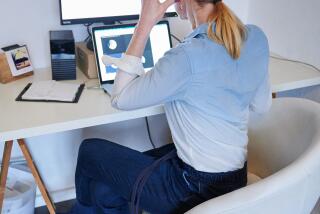This is how many pounds you can lose in a year by standing for six hours a day instead of sitting
- Share via
Brace yourself: The calorie-burning benefits of standing versus sitting will not, at first blush, blow you out of your seat. Spend a minute upright instead of seated, and the additional energy expended amounts to less than one-tenth of a calorie (0.04 of a calorie, to be exact).
But a new study that combines the best available research on sitting, standing and energy expenditure invites readers (reclining and otherwise) to consider the potential long-term effects of this seemingly marginal difference.
The average American sits for more than seven hours of every day, making us among the most sedentary humans on Earth. But if Homo americanus were to spend six of those hours simply standing on his feet instead, that reformed couch potato would burn an additional 54 calories a day.
Without any changes in his diet or a single extra visit to the gym, those 54 calories per day could translate into a loss of about 5.5 pounds of body fat per year for that average American.
And since he’s upright anyway, if that increased standing time led to, say, more walking or pacing (or squatting, lifting or flexing), the weight loss could be substantially increased.
This isn’t rocket science. These are simple calculations of thermogenesis that remind Americans why they should stand more and sit less, said Mayo Clinic cardiologist Francisco Lopez-Jimenez, the senior author of the new analysis. The research, which distills the findings of 46 studies with a combined enrollment of 1,184 participants, was published Wednesday in the European Journal of Preventive Cardiology.
“Standing burns more calories than sitting,” Lopez-Jimenez said. “That has some implications for long-term weight control, and it has some potential too to be used in weight-control strategies.”
Not surprisingly, that extra calorie burning comes from the fact that standing recruits more muscle groups than does sitting. The increased energy required to remain upright varies between men and women, probably reflecting their different sizes and degree of muscle tone, the study found.
In seven of the 46 studies that undergirded the analysis, researchers measured differences in calorie burning by men and women who stood rather than sat. On average, those studies showed the difference in energy expenditure to be 0.1 of a calorie per minute among women and a heftier 0.19 of a calorie per minute for men.
The new study stands as a counterpoint to related research on the dangers of sitting for long periods.
A 2015 analysis of studies established that people who sit for long hours raise their average risk of Type 2 diabetes, cardiovascular disease, cancer and early death. Even those that break up that sitting for intensive exercise face a 16% higher risk of premature death than do those who don’t sit for large parts of their day.
A study published in September 2017 measured the “bout length” of participants’ sitting spells, and found that those who sat for longer stretches of time without getting up were more likely to die during the study’s four-year follow-up period than did those who got up and moved around more often.
Such findings have created a frenzied market for standing desks, which make it easier for desk-bound office workers to stand while typing, talking and generally remaining tethered to a workspace.
AcuteMarketReports.com recently issued an analysis forecasting double-digit growth for the global standing desk market between 2017 and 2025. As employers and individual workers overhaul workspaces with an eye toward fostering better health, the market for standing desks was predicted to reach $2.8 billion by 2025.
But the research on whether, and how much, standing fosters better health is still young: The length of time subjects spend pinned in their chairs differs in various studies, as does the frequency and duration of their standing, and whether (or how much) they get more intensive exercise.
The effects of standing have only begun to come under rigorous scrutiny. Lopez-Jimenez said his research team hopes to expand its work to determine the effects of standing versus sitting on risk factors for high blood pressure, high cholesterol and cardiovascular disease.
And, he acknowledged, they will have to allow for the possibility that there are downsides to prolonged standing, including exacerbating different kinds of back pain and causing leg soreness and even varicosity as blood pools in the feet and ankles. They must also explore the likelihood that, as the muscles used in standing grow more acclimated to that challenge (a good thing, to be sure), standers will have to do more if they want to burn those extra calories.
In short, don’t be fooled: Once researchers and public health advocates get you up out of your chair, they’re unlikely to stop there. They’ll want you to walk during meetings, to pump light weights with your free hand, to take 10-minute fitness breaks and to squeeze in a more intensive workout too if you can.
“We talk a lot about the need to avoid sitting for too long, and I think the interpretation of that for some people is, ‘OK, let’s just stand,’” Lopez-Jimenez said. “But the solution is not just to stand all those hours.”
Once you are out of your seat, Lopez-Jimenez and his colleagues are pretty sure you won’t want to just stand there either.
“We all know that when someone’s standing, they’re more likely to naturally move around” — to speak to a colleague in the next office rather than messaging her, to fetch a paper from the printer tray, or to pitch balled-up paper at a nearby basket, he said.
Small movements like these can add up, according to Dr. James A. Levine of the Mayo Clinic, author of the 2014 book “Get Up! Why Your Chair Is Killing You and What You Can Do About It.”
Levine, an endocrinologist, is a passionate advocate for what he calls “non-exercise activity thermogenesis” (NEAT) as a way to restore movement, control weight and counteract the health effects of our sedentary ways.
NEAT includes everything from pacing and fidgeting to a person’s propensity to get up and dance on a sudden impulse (something the hyperkinetic Dr. Levine seems poised at any given moment to do).
We all do these things already, he says: In fact, it appears that individuals’ different levels of NEAT may account for as many as 2,000 calories daily, which is roughly the range of variation among adult humans in daily caloric burn.
Look, he says, and you may notice that the trim guy who eats potato chips with his lunch every day simply wiggles, fidgets and springs up from his chair more than the chubbier, more sedate salad-eater in the next cubicle. Levine has found that when lean, healthy adults are “overfed” in a lab, their almost imperceptible muscle movements increase to burn off the surplus.
The key to weight maintenance, he concludes, is to crank more NEAT into our days.
That means switching to a standing desk, of which he and Lopez-Jimenez are big fans. But it also means hopping and pacing while watching TV or chatting on the phone, taking meetings on a hiking trail, sitting on a ball that challenges your balance, and using all sorts of under-desk gadgets that flex the ankles, work the calves and demand just a little extra from the muscles.
And occasionally, get up and dance.
MORE IN SCIENCE
Brain scans reveal that friends really are on the same wavelength
Sleep cycle troubles may be early sign of Alzheimer’s disease
Military families bolster the case that obesity is indeed contagious







